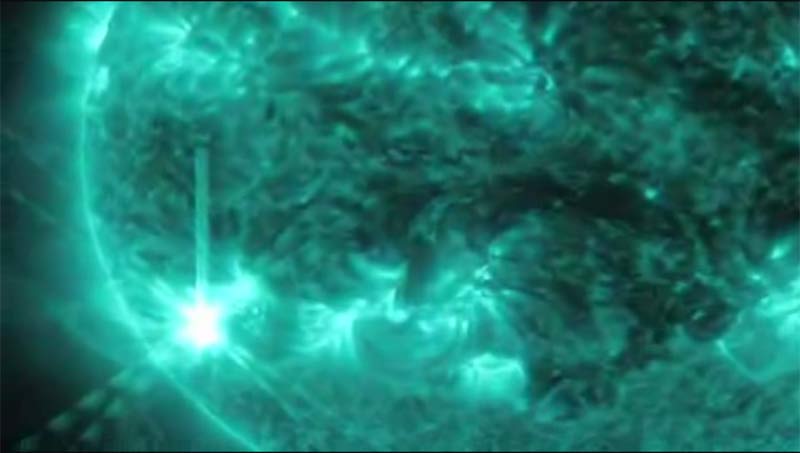Solar Storm Expected to Hit Earth Tuesday

A medium-size solar flare erupted from the sun this weekend, hurling a cloud of plasma and charged particles toward Earth on a cosmic path that is expected to deliver a glancing blow to our planet tomorrow (July 31), according to space weather forecasters.
The M6-class solar flare exploded from the sun on Saturday (July 28), unleashing a wave of plasma and charged particles, called a coronal mass ejection (CME), into space. The CME is expected to reach Earth tomorrow, and could deliver a glancing blow to Earth's magnetic field at around 11 a.m. EDT (1500 GMT), according to the website Spaceweather.com, which regularly monitors space weather events.
"This is a slow-moving CME," astronomer Tony Phillips wrote on Spaceweather.com. "The cloud's low speed (382 km/s estimated) combined with its glancing trajectory suggests a weak impact is in the offing. Nevertheless, polar geomagnetic storms are possible when the cloud arrives."
Powerful, fast-moving CMEs that hit Earth directly can trigger strong geomagnetic storms that cause radio blackouts and disrupt power grids and other communications infrastructure. These clouds of charged particles can also knock out satellites as they travel through space.
A more benign effect of solar storms, however, is supercharged northern and southern lights, which can be sparked when the CME's charged particles hit Earth's magnetic field. Solar storm forecasts are often accompanied by alerts for auroras at high- and mid-latitudes, though particularly strong geomagnetic storms can generate auroras at lower-than-normal latitudes.
Saturday's M6-class solar flare erupted from the active sunspot AR1532, which is slowly rotating across the solar disk. X-class solar flares are the strongest type of solar eruptions, with M-class flares ranking as medium-strength, and C-class flares representing the weakest type. [Video: Strong Sun Flare Erupts Towards Earth]
While Earth may be safe from being hit head-on by the CME, Mercury, the planet closest to the sun, will not be as lucky.
Get the Space.com Newsletter
Breaking space news, the latest updates on rocket launches, skywatching events and more!
"The CME will also hit Mercury, probably with greater force," Phillips wrote on Spaceweather.com. "Mercury's planetary magnetic field is only ~10 percent as strong as Earth's, so Mercury is not well protected from CMEs. When the clouds hit, they can actually scour atoms off Mercury's surface, adding material to Mercury's super-thin atmosphere and comet-like tail."
The sun's activity waxes and wanes on a roughly 11-year cycle. The sun's current cycle, called Solar Cycle 24, began in 2008. The sun's activity is expected to ramp up toward a solar maximum in 2013.
Editor's note: If you snap aurora or sunspot photos that you'd like to be considered for use in a story or gallery, please send them to SPACE.com managing editor Tariq Malik at tmalik@space.com.
Follow SPACE.com on Twitter @Spacedotcom. We're also on Facebook and Google+.
Join our Space Forums to keep talking space on the latest missions, night sky and more! And if you have a news tip, correction or comment, let us know at: community@space.com.

Space.com is the premier source of space exploration, innovation and astronomy news, chronicling (and celebrating) humanity's ongoing expansion across the final frontier. Originally founded in 1999, Space.com is, and always has been, the passion of writers and editors who are space fans and also trained journalists. Our current news team consists of Editor-in-Chief Tariq Malik; Editor Hanneke Weitering, Senior Space Writer Mike Wall; Senior Writer Meghan Bartels; Senior Writer Chelsea Gohd, Senior Writer Tereza Pultarova and Staff Writer Alexander Cox, focusing on e-commerce. Senior Producer Steve Spaleta oversees our space videos, with Diana Whitcroft as our Social Media Editor.









